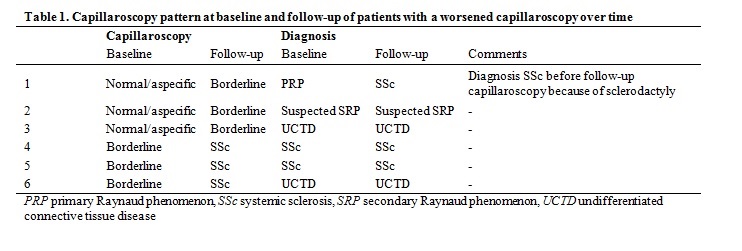Session Information
Session Type: Abstract Submissions (ACR)
Background/Purpose Nailfold capillaroscopy is an important tool to differentiate primary Raynaud’s phenomenon (PRP) from secondary Raynaud’s phenomenon (SRP). Based on possible transition from PRP to SRP (semi)annual capillaroscopy has been advocated to detect transition to SRP as early as possible.
Objective of this study is to evaluate the additive diagnostic value of repeated nailfold capillaroscopy after one year in patients with Raynaud’s phenomenon (RP).
Methods Patients with RP who underwent capillaroscopy at the outpatient clinic at least six months ago were invited for follow-up capillaroscopy. PRP was defined according to the definition of LeRoy (1); SRP was defined as RP associated with a connective tissue disease fulfilling applicable diagnostic criteria; the remaining patients were classified as suspected SRP (sSRP). The number of patients in which follow-up capillaroscopy resulted in change of diagnosis was determined.
Results In total 107 patients with RP underwent capillaroscopy. Of these71 underwent follow-up capillaroscopy after a mean period of 12 months (range 6-25 months). At baseline, eight (11%) patients had PRP, 28 (40%) SRP and 35 (49%) sSRP. The rate of progression from PRP to SRP was 12.5% (one of eight patients). The rate of progression from sSRP to SRP was 3% (one of 35 patients). Capillaroscopy pattern changed in 21 (30%) patients: six (8%) worsened (Table 1) and 15 (21%) improved. In total five patients (7%) had a different diagnosis at follow-up, two of which based on clinical symptoms, three based on capillaroscopy pattern only: one changed from PRP to SRP, based on development of sclerodactyly, one changed from sSRP to SRP based on biopsy proven myositis, and three patients changed from sSRP to PRP due to normalization of capillaroscopy (Table 2). Thus, capillaroscopy contributed to change in diagnosis in three out of 43 patients (7%) with PRP or sSRP, all improving from sSRP to PRP.
Conclusion Although progression from PRP to SRP was observed in 12.5% and progression from sSRP to SRP in 3%, changes in capillaroscopy did not contribute to change in clinical diagnosis in these patients.Based on the findings of this study, a follow-up capillaroscopy after one year in patients with PRP or sSRP without a change in clinical symptoms cannot be advocated. Extended follow-up in a larger population is needed to confirm this observation.
(1) LeRoy EC, Medsger TA, Jr. Raynaud’s phenomenon: a proposal for classification. Clin Exp Rheumatol 1992 Sep;10(5):485-8.
Disclosure:
B. de Boer,
None;
J. Meijs,
Actelion Pharmaceuticals Ltd,
2;
J. van Aken,
None;
T. W. J. Huizinga,
None;
A. A. Schouffoer,
None;
J. K. de Vries-Bouwstra,
None.
« Back to 2014 ACR/ARHP Annual Meeting
ACR Meeting Abstracts - https://acrabstracts.org/abstract/the-value-of-repeated-nailfold-capillaroscopy-in-raynauds-phenomenon-in-daily-practice-a-follow-up-study-in-the-netherlands/


